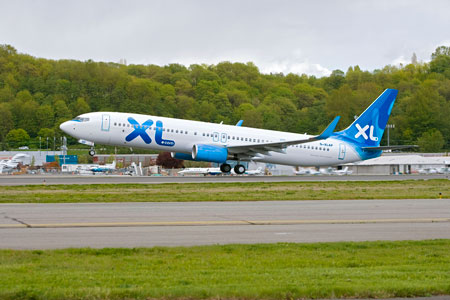 (Airbus) In its continuing efforts toward eco-efficiency – and to help the whole aviation sector prosper with less impact on the environment, such as reducing emissions from aircraft operations – Airbus has teamed with Honeywell Aerospace; UOP, a Honeywell Company; International Aero Engines (IAE); and JetBlue Airways to pursue development of a sustainable second-generation biofuel for use in commercial aircraft.
(Airbus) In its continuing efforts toward eco-efficiency – and to help the whole aviation sector prosper with less impact on the environment, such as reducing emissions from aircraft operations – Airbus has teamed with Honeywell Aerospace; UOP, a Honeywell Company; International Aero Engines (IAE); and JetBlue Airways to pursue development of a sustainable second-generation biofuel for use in commercial aircraft.
The companies’ joint activity will help develop renewable energy technology to convert vegetation – and algae-based oils into aviation fuels and to evaluate the challenges for obtaining approval for this fuel by standards organizations. Such non-food-crop biomass fuels are known to provide a better fuel-to-emissions lifecycle than current kerosene.
JetBlue, IAE, Honeywell and Airbus are examining the benefits of jet fuels derived from renewable biomass sources that do not compete with existing food production or valuable land and water resources. This “second-generation bio-jet” fuel used will be produced using technology developed by Honeywell’s UOP, a leading developer of technology and products for the refining industry. UOP has developed a process to convert biological material into renewable jet fuel that performs identically to traditional fuels while meeting the stringent performance specifications for flight.
“Over the last 40 years, aviation has reduced fuel burn – and therefore carbon dioxide emissions – by 70 percent, but more needs to be done,” said Sebastien Remy, Head of Alternative Fuels Research Programs for Airbus. “Millions of barrels of kerosene are used each day for aircraft fuel, and worldwide demand is growing. In order to replace a significant portion of that jet fuel with bio-jet, we need to find something that has much greater yield than the current biomass sources available. Airbus believes that second-generation bio-jet could provide up to 30 percent of all commercial aviation jet fuel by 2030.”
The potential environmental advantages of using second-generation bio-jet are extensive, including reduced emissions and particulates; reduced carbon footprint; improved engine cleanliness; reduced contrail formation; and overall lifecycle benefits. In addition to investigating the environmental benefits, the partnership will conduct research into whether biofuels could potentially be developed that will expand payload-range aircraft performance, reduce fuel burn, and increase engine reliability and durability – all critical cost points for aircraft operators.
“This has the potential to benefit every world citizen beyond those involved in our business,” said Russ Chew, President and Chief Operating Officer of JetBlue Airways. “Each of our companies has the social responsibility to work toward developing a cleaner way to do business, and this effort we are undertaking with Airbus, Honeywell and IAE is a major stepping stone toward further reducing our environmental impact.”
Source: Airbus

 (Airbus) In its continuing efforts toward eco-efficiency – and to help the whole aviation sector prosper with less impact on the environment, such as reducing emissions from aircraft operations – Airbus has teamed with Honeywell Aerospace; UOP, a Honeywell Company; International Aero Engines (IAE); and JetBlue Airways to pursue development of a sustainable second-generation biofuel for use in commercial aircraft.
(Airbus) In its continuing efforts toward eco-efficiency – and to help the whole aviation sector prosper with less impact on the environment, such as reducing emissions from aircraft operations – Airbus has teamed with Honeywell Aerospace; UOP, a Honeywell Company; International Aero Engines (IAE); and JetBlue Airways to pursue development of a sustainable second-generation biofuel for use in commercial aircraft.